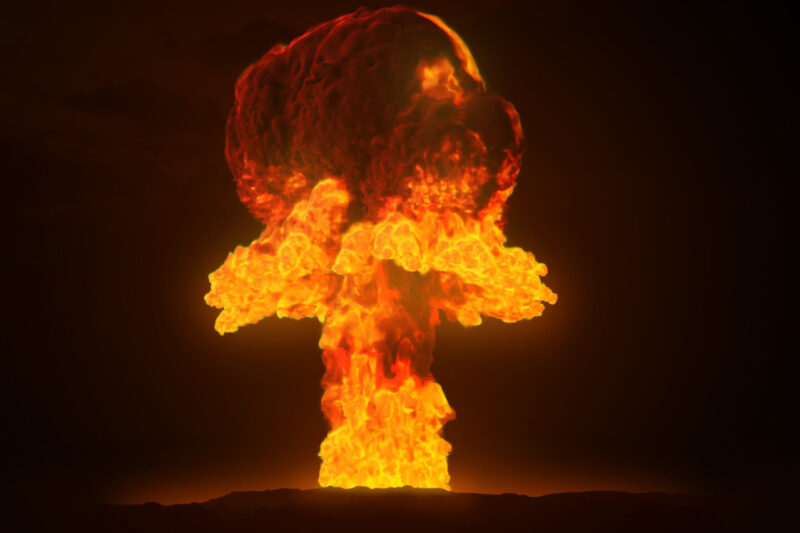
This month, United States President Joe Biden warned that the world could face armageddon if his Russian counterpart, Vladimir Putin, were to use a tactical nuclear weapon in Ukraine. You would imagine that such a prognosis would lead to urgent action to dial down the confrontation. Yet no effort is being made to move us back from that risk.
On the contrary, governments on all sides are piling on more threats, more militarisation and more actions that are not just making nuclear war possible, but are increasing its probability.
Last week, NATO began a round of nuclear exercises simulating the dropping of ‘tactical’ B61 nuclear bombs over Europe. Although these drills are presented as routine, they are occurring alongside parallel Russian exercises. It’s hard to imagine worse timing.
Surely with concerns about armageddon expressed at the very highest levels of power, these exercises should have been called off as a message that the West won’t contribute to escalating nuclear tensions? Instead, our leaders are systematically failing to reduce the risk.
Still, there are powerful messages that should be listened to and acted upon. In August — even before Putin’s latest, thinly veiled nuclear threats — United Nations Secretary General Antonio Guterres warned that the world is “one miscalculation away from nuclear annihilation”. His words must serve as a wake-up call to leaders who pursue policies inexorably driving us towards nuclear war and to populations that are not yet taking action to stop these terrible dangers.
Guterres warned that we are at a time of nuclear danger “not seen since the height of the Cold War”. He cautioned against countries seeking “false security” by spending vast sums on “doomsday weapons”. He said that the world had been lucky that nuclear weapons have not been used since 1945. But as he rightly stated: “Luck is not a strategy. Nor is it a shield from geopolitical tensions boiling over into nuclear conflict.”
Indeed, we cannot rely on luck. And we must remember what nuclear use means and understand what nuclear war would look like today.
An estimated 340,000 people died after the US dropped atomic bombs over Hiroshima and Nagasaki in Japan in 1945. That included many who survived the immediate blast but died shortly afterwards from fatal burns. Others died because of the complete breakdown of rescue and medical services that had also been destroyed. And many more died when the impact of radiation kicked in, poisoning people and causing cancers and birth deformities.
If that isn’t bad enough, consider this: The Hiroshima bomb was actually a small nuclear bomb in today’s terms. Current nuclear weapons — even the supposedly limited-range, battlefield-oriented ‘tactical’ nuclear weapons now routinely discussed in the context of the Ukraine war — are many, many times more powerful. The ones that the current exercises over Europe are designed for have variable yields of up to 20 times greater strength than the bomb that destroyed Hiroshima in 1945.
Equally worrying are the recent policies of nuclear weapons states. We had seen gradual reductions in nuclear weapons for a few decades. Now we are seeing modernisation programmes on all sides, with the US planning an upgrade of missiles that can deliver nuclear weapons, France launching a project to build a new generation of nuclear-powered ballistic missile submarines, and Britain, India and Pakistan preparing to increase their nuclear arsenals.
But worst of all is the sanitising of the idea of nuclear use. It seems that the mutually assured destruction theory that prevailed during the Cold War – that these weapons will never actually be used – has been abandoned.
Today’s policies specifically include nuclear use, including in conventional wars, even against countries that don’t have nuclear weapons. The taboo on nuclear use is over, and the global community has to face up to that reality because the impacts of nuclear war cannot be confined to a single country or even to a region. Such a war presents an existential threat to all humanity and to all forms of life. Nuclear disarmament is a prerequisite for our survival.
It’s not just the peace movement that makes this case. In fact, the global majority actively works for a nuclear weapons-free world and is very aware that it is the activities of a tiny minority of states – just nine with nuclear weapons – that hold us all at risk of annihilation. That’s why virtually the entire Global South is already self-organised into nuclear weapons-free zones. The nuclear Non-Proliferation Treaty and the Treaty on the Prohibition of Nuclear Weapons are initiatives from the Global South. That is where the good sense lies, and it is to this championing of nuclear disarmament that we must turn, for security based on humanity and peace, not on destruction and death.
In the 1980s, the former Swedish prime minister, the great Olof Palme, pioneered the principle of common security – that no state or community can be secure without others experiencing that same level of security. It’s a concept whose time has come. Europe and the world badly need a common security framework, not massively increasing militarisation. The idea that might makes right or that thousands of people can be sent to slaughter and be slaughtered must never be acceptable.
In January, the leaders of the US, Russia, China, France and the United Kingdom issued a statement affirming “that a nuclear war cannot be won and must never be fought”. As we enter UN Disarmament Week on Monday, we must all urge those leaders to act on that commitment.
Nuclear disarmament, backed by the global majority of states and a new approach to common security, can yet save our world. But time is running out: We must take action to secure our future.
Source: Al-Jazeera